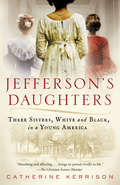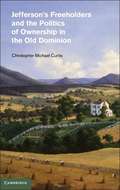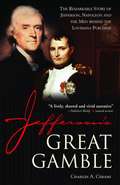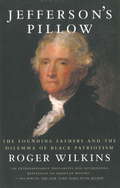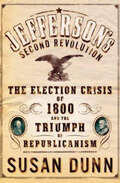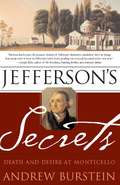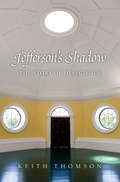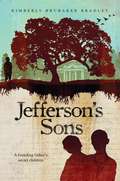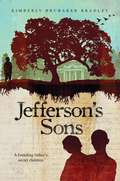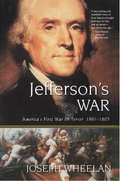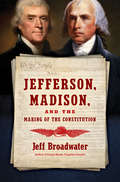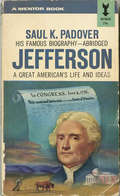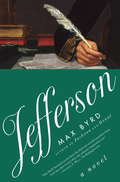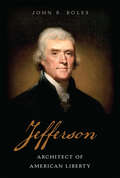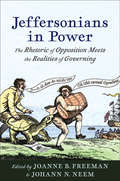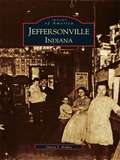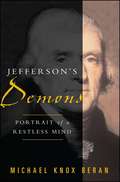- Table View
- List View
Jefferson's Daughters: Three Sisters, White and Black, in a Young America
by Catherine KerrisonThe remarkable untold story of Thomas Jefferson’s three daughters—two white and free, one black and enslaved—and the divergent paths they forged in a newly independent America Thomas Jefferson had three daughters: Martha and Maria by his wife, Martha Wayles Jefferson, and Harriet by his slave Sally Hemings. In Jefferson’s Daughters, Catherine Kerrison, a scholar of early American and women’s history, recounts the remarkable journey of these three women—and how their struggle to define themselves reflects both the possibilities and the limitations that resulted from the American Revolution. Although the three women shared a father, the similarities end there. Martha and Maria received a fine convent school education while they lived with their father during his diplomatic posting in Paris—a hothouse of intellectual ferment whose celebrated salonnières are vividly brought to life in Kerrison’s narrative. Once they returned home, however, the sisters found their options limited by the laws and customs of early America. Harriet Hemings followed a different path. She escaped slavery—apparently with the assistance of Jefferson himself. Leaving Monticello behind, she boarded a coach and set off for a decidedly uncertain future. For this groundbreaking triple biography, Kerrison has uncovered never-before-published documents written by the Jefferson sisters when they were in their teens, as well as letters written by members of the Jefferson and Hemings families. She has interviewed Hemings family descendants (and, with their cooperation, initiated DNA testing) and searched for descendants of Harriet Hemings. The eventful lives of Thomas Jefferson’s daughters provide a unique vantage point from which to examine the complicated patrimony of the American Revolution itself. The richly interwoven story of these three strong women and their fight to shape their own destinies sheds new light on the ongoing movement toward human rights in America—and on the personal and political legacy of one of our most controversial Founding Fathers.
Jefferson's Freeholders and the Politics of Ownership in the Old Dominion
by Christopher Michael CurtisJefferson's Freeholders and the Politics of Ownership in the Old Dominion explores the historical processes by which Virginia was transformed from a British colony into a Southern slave state. It focuses on changing conceptualizations of ownership and emphasizes the persistent influence of the English common law on Virginia's postcolonial political culture. The book explains how the traditional characteristics of land tenure became subverted by the dynamic contractual relations of a commercial economy and assesses the political consequences of the law reforms that were necessitated by these developments. Nineteenth-century reforms seeking to reconcile the common law with modern commercial practices embraced new democratic expressions about the economic and political power of labor, and thereby encouraged the idea that slavery was an essential element in sustaining republican government in Virginia. By the 1850s, the ownership of human property had replaced the ownership of land as the distinguishing basis for political power, with tragic consequences for the Old Dominion.
Jefferson's Great Gamble
by Charles A. CeramiJefferson's Great Gamble tells the incredible story of how four leaders of an upstart nation--Jefferson, Madison, Monroe and Livingston--risked the future of their country and their own careers; outwitted Napoleon Bonaparte, the world's most powerful ruler; and secured a new future for the United States of America. <br><br>For two years before the Louisiana Purchase, the nine principal players in the deal watched France and the United States approach the brink of war over the most coveted spot on the planet: a bustling port known as New Orleans. And until the breakthrough moment when a deal was secured, the men who steered their countries through the tense and often beguiling negotiations knew only that the futures of both nations were being questioned, and that the answer was uncertain. <br><br>Jefferson's Great Gamble is an extraordinary work that redefines one of the most important and overlooked events in American history. Charles A. Cerami reveals the untold thrusts and parries of the Louisiana Purchase, an event that was not just a land sale, but thirty months of high drama, blandishment, posturing and secret maneuvers by some of the most powerful and crafty men of their time. Utilizing original correspondence and firsthand accounts, Cerami paints a vivid and engrossing narrative enriched by the words of the men whose talents and weaknesses kept the negotiations alive during the most unsure moments. <br><br>When Thomas Jefferson took office as president of the United States in 1801, Louisiana was at the front of his mind. Jefferson knew that the future of the country hinged on its right to navigate the Mississippi River and have access to New Orleans. His hopes for maintaining this right were almost completely dashed when it was discovered that Napoleon had secretly forced Spain to give the Louisiana Territory to France, and that he had troops on the way to take possession of New Orleans. <br><br>Jefferson's only hope to stop the takeover lay in a great gamble: convincing Napoleon that the United States was willing to go to war over the port city. Jefferson knew that war might fracture the new country, which at the time had roughly one thousand men in its army. He was therefore faced with not only convincing Napoleon that the United States was ready to fight, but bluffing him into thinking that it could win that battle. <br><br>To execute his plan, Jefferson turned to his brilliant but troubled foreign-relations team. James Madison, the wily secretary of state, devised with Jefferson a disinformation strategy that was remarkable for its ingenuity and effectiveness. Robert Livingston, the American envoy to France, struggled to negotiate with French officials while being disdained and ignored by Jefferson and Madison, his political rivals. And as the final negotiations approached, James Monroe found himself sailing to Paris with the key to how the United States would execute the endgame. <br><br>Napoleon was bombarded by contradicting opinions from his two closest advisors. Fran#xE7;ois de Barb#xE9;-Marbois, the impeccably honest finance minister, pushed toward a sale to raise money for a war with England. Charles-Maurice de Tallyrand-P#xE9;rigord, Napoleon's witty and corrupt chief advisor, pushed him to hold on to the colony, a position he believed held long-term benefits for France, if not for Napoleon. <br><br>To read Jefferson's Great Gamble is to experience the tense days and nights leading to a decision that changed the face of the world. From the early American infighting to the heated French negotiations to the battle needed years later to secure the purchase, this new history is a story of dedicated men, each driven by love of country, who created an event that Robert Livingston called "the noblest work of our lives. "
Jefferson's Pillow
by Roger WilkinsAn outspoken participant in the civil rights movement, Roger Wilkins served as Assistant Attorney General during the Johnson administration. In 1972 he was awarded the Pulitzer Prize along with Bernstein and Herblock for his coverage of Watergate. Yet this black man, who has served the United States so well, feels at times an unwelcome guest here. In Jefferson's Pillow, Wilkins returns to America's beginnings and the founding fathers who preached and fought for freedom, even though they owned other human beings and legally denied them their humanity. He asserts that the mythic accounts of the American Revolution have ignored slavery and oversimplified history until the heroes, be they the founders or the slaves in their service, are denied any human complexity. Wilkins offers a thoughtful analysis of this fundamental paradox through his exploration of the lives of George Washington, George Mason, James Madison, and of course Thomas Jefferson. He discusses how class, education, and personality allowed for the institution of slavery, unravels how we as Americans tell different sides of that story, and explores the confounding ability of that narrative to limit who we are and who we can become. An important intellectual history of America's founding, Jefferson's Pillow will change the way we view our nation and ourselves.
Jefferson's Poplar Forest: Unearthing a Virginia Plantation
by Barbara J. Heath and Jack GaryThomas Jefferson once called his plantation Poplar Forest, "the most valuable of my possessions." For Jefferson, Poplar Forest was a private retreat for him to escape the hordes of visitors and everyday pressures of his iconic estate, Monticello.Jefferson's Poplar Forest uses the knowledge gained from long-term and interdisciplinary research to explore the experiences of a wide range of people who lived and worked there between the American Revolution and the Civil War. Multiple archaeological digs reveal details about the lives of Jefferson, subsequent owners and their families, and the slaves (and descendants) who labored and toiled at the site. From the plantation house to the weeds in the garden, Barbara Heath, Jack Gary, and numerous contributors examine the landscapes of the property, investigating the relationships between the people, objects, and places of Poplar Forest.As the first book-length study of the archaeology of a president's estate, Jefferson's Poplar Forest offers a compelling and uniquely specific look into the lives of those who called Poplar Forest home.
Jefferson's Second Revolution: The Election Crisis of 1800 and the Triumph of Republicanism
by Susan DunnAn &“excellent&” history of the tumultuous early years of American government, and a constitutional crisis sparked by the Electoral College (Booklist). In the election of 1800, Federalist incumbent John Adams, and the elitism he represented, faced Republican Thomas Jefferson. Jefferson defeated Adams but, through a quirk in Electoral College balloting, tied with his own running mate, Aaron Burr. A constitutional crisis ensued. Congress was supposed to resolve the tie, but would the Federalists hand over power peacefully to their political enemies, to Jefferson and his Republicans? For weeks on end, nothing was certain. The Federalists delayed and plotted, while Republicans threatened to take up arms. In a way no previous historian has done, Susan Dunn illuminates this watershed moment in American history. She captures its great drama, gives us fresh, finely drawn portraits of the founding fathers, and brilliantly parses the enduring significance of the crisis. The year 1800 marked the end of Federalist elitism, pointed the way to peaceful power shifts, cleared a place for states&’ rights in the political landscape—and set the stage for the Civil War. &“Dunn, a scholar of eighteenth-century American history, has provided a valuable reminder of an election in which the stakes were truly enormous and the political vituperation was far more poisonous than the relatively moderate attacks heard today. . . . An excellent work that effectively explains this critical contest that shaped the history of the new republic.&” —Booklist &“Dunn does a superb job of recounting the campaign, its cast of characters, and the election&’s bizarre conclusion in Congress. That tense standoff could have plunged the country into a disastrous armed conflict, Dunn explains, but instead cemented the legitimacy of peaceful, if not smooth, transfers of power.&” —Publishers Weekly &“Dunn simultaneously teaches and enthralls with her eloquent, five-sensed descriptions of the people and places that shaped our democracy.&” —Entertainment Weekly
Jefferson's Secrets: Death and Desire at Monticello
by Andrew BursteinWhen Thomas Jefferson died on July 4, 1826, he left behind a series of mysteries that have captured the imaginations of historical investigators for generations. In Jefferson's Secrets, Andrew Burstein draws on sources previous biographers have glossed over or missed entirely. Beginning with Jefferson's last days, Burstein shows how Jefferson confronted his own mortality. Burstein also tackles the crucial questions history has yet to answer: Did Jefferson love Sally Hemings? What were his attitudes towards women? Did he believe in God? How did he wish to be remembered? The result is a profound and nuanced portrait of the most complex of the Founding Fathers.
Jefferson's Shadow
by Keith ThomsonIn the voluminous literature on Thomas Jefferson, little has been written about his passionate interest in science. This new and original study of Jefferson presents him as a consummate intellectual whose view of science was central to both his public and his private life. Keith Thomson reintroduces us in this remarkable book to Jefferson's eighteenth-century world and reveals the extent to which Jefferson used science, thought about it, and contributed to it, becoming in his time a leading American scientific intellectual. With a storyteller's gift, Thomson shows us a new side of Jefferson. He answers an intriguing series of questions—How was Jefferson's view of the sciences reflected in his political philosophy and his vision of America's future? How did science intersect with his religion? Did he make any original contributions to scientific knowledge?—and illuminates the particulars of Jefferson's scientific endeavors. Thomson discusses Jefferson's theories that have withstood the test of time, his interest in the practical applications of science to societal problems, his leadership in the use of scientific methods in agriculture, and his contributions toward launching at least four sciences in America: geography, paleontology, climatology, and scientific archaeology. A set of delightful illustrations, including some of Jefferson's own sketches and inventions, completes this impressively researched book.
Jefferson's Sons
by Bradley Kimbery BrubakerThe untold story of Thomas Jefferson's slave children Beverly, Harriet, Madison, and Eston are Thomas Jefferson's children by one of his slaves, Sally Hemings, and while they do get special treatment - better work, better shoes, even violin lessons - they are still slaves, and are never to mention who their father is. The lighter-skinned children have been promised a chance to escape into white society, but what does this mean for the children who look more like their mother? As each child grows up, their questions about slavery and freedom become tougher, calling into question the real meaning of "life, liberty, and the pursuit of happiness. " Told in three parts from the points of view of three of Jefferson's slaves - Beverly, Madison, and a third boy close to the Hemings family - these engaging and poignant voices shed light on what life was like as one of Jefferson's invisible offspring.
Jefferson's Sons
by Kimberly Brubaker BradleyThe untold story of Thomas Jefferson's slave children Beverly, Harriet, Madison, and Eston are Thomas Jefferson's children by one of his slaves, Sally Hemings, and while they do get special treatment--better work, better shoes, even violin lessons--they are still slaves, and are never to mention who their father is. The lighter-skinned children have been promised a chance to escape into white society, but what does this mean for the children who look more like their mother? As each child grows up, their questions about slavery and freedom become tougher, calling into question the real meaning of "life, liberty, and the pursuit of happiness." Told in three parts from the points of view of three of Jefferson's slaves--Beverly, Madison, and a third boy close to the Hemings family--these engaging and poignant voices shed light on what life was like as one of Jefferson's invisible offspring.
Jefferson's Sons: A Founding Father's Secret Children
by Kimberly Brubaker Bradley<P>This story of Thomas Jefferson's children by one of his slaves, Sally Hemings, tells a darker piece of America's history from an often unseen perspective-that of three of Jefferson's slaves-including two of his own children. <P>As each child grows up and tells his story, the contradiction between slavery and freedom becomes starker, calliing into question the real meaning of "life, liberty, and the pursuit of happiness." This poignant story sheds light on what life was like as one of Jefferson's invisible offspring.
Jefferson's Sons: A Founding Father's Secret Children
by Kimberly Brubaker BradleyThis story of Thomas Jefferson's children by one of his slaves, Sally Hemings, tells a darker piece of America's history from an often unseen perspective-that of three of Jefferson's slaves-including two of his own children. As each child grows up and tells his story, the contradiction between slavery and freedom becomes starker, calliing into question the real meaning of "life, liberty, and the pursuit of happiness." This poignant story sheds light on what life was like as one of Jefferson's invisible offspring.
Jefferson's War: America's First War on Terror 1801-1805
by Joseph WheelanAuthor Joseph Wheelan has marvelously captured the story of America’s war against the Barbary pirates, our first war against terror and the nations that support it. The Barbary pirates, a Muslim enemy from Tripoli, attacked European and American merchant shipping with impunity. Jefferson ordered the U. S. Navy to Tripoli in 1801 to repel "force with force. " The Barbary War was also a proving ground for such young officers as William Bainbridge, Stephen Decatur, Isaac Hull, and David Porter -key players in the impending War of 1812 against Great Britain.
Jefferson, Madison, and the Making of the Constitution
by Jeff BroadwaterThomas Jefferson, author of the Declaration of Independence, and James Madison, "Father of the Constitution," were two of the most important Founders of the United States as well as the closest of political allies. Yet historians have often seen a tension between the idealistic rhetoric of the Declaration and the more pedestrian language of the Constitution. Moreover, to some, the adoption of the Constitution represented a repudiation of the democratic values of the Revolution. In this book, Jeff Broadwater explores the evolution of the constitutional thought of these two seminal American figures, from the beginning of the American Revolution through the adoption of the Bill of Rights. In explaining how the two political compatriots could have produced such seemingly dissimilar documents but then come to a common constitutional ground, Broadwater reveals how their collaboration--and their disagreements--influenced the full range of constitutional questions during this early period of the American republic.
Jefferson: A Great American's Life and Ideas
by Samuel K. PadoverThis famous biography has been in print for more than 40 years and stands as Jefferson's life story. It traces his life from his childhood as the son of a Virginia planter, to his years as a lawyer, to the Revolutionary War and the early years of the Union
Jefferson: A Novel
by Max ByrdAs he did with Presidents Jackson and Grant in those magnificent novels, Max Byrd now reveals Thomas Jefferson as we've never seen before. Byrd transports us to 1784, as Jefferson, the newly appointed American ambassador to the court of Louis XVI and Marie Antoinette, arrives in Paris--a city adrift in intrigue, upheaval, and temptation that will challenge his principles, incite his passions, and change him forever. Through the eyes of his impressionable young secretary, William Short, readers watch as the future president builds his dream of America with fellow patriots John Adams and Ben Franklin, while struggling between political ambition and an unexpected crisis of the heart with a woman who has the power to destroy him. Behind the face this complex Virginian shows the world, Thomas Jefferson is an enigmatic statesman who fights for individual liberty even as he keeps slaves, who champions free will even as he denies it to his daughters, and who holds men to the highest standards of honor--even as he embarks on a shadowy double life of his own. "Max Byrd's historical novels about the third and seventh presidents bring both men alive in ways that only a literary imagination can."--George F. Will, The Washington Post "Jefferson has the organic intimacy of a novel that has sprung full-blown from the imagination of its creator."--The New York Times "Superb . . . fascinating in the psychological insight it provides to one of the greatest Americans . . . a truly memorable book."--W. Jackson Bate, Pulitzer Prize-winning author of Samuel Johnson and John Keats "Absolutely splendid historical fiction that resonates with international, provincial, and individual passion and drama."--Booklist "A real tour de force."--San Francisco ChronicleFrom the Trade Paperback edition.
Jefferson: Architect Of American Liberty
by John B. BolesFrom an eminent scholar of the American South, the first full-scale biography of Thomas Jefferson since 1970As Alexander Hamilton's star has risen, Thomas Jefferson's has fallen, largely owing to their divergent views on race. Once seen as the most influential American champion of liberty and democracy, Jefferson is now remembered largely for his relationship with his slave Sally Hemmings, and for electing not to free her or most of the other people he owned.In this magisterial biography, the eminent scholar John B. Boles does not ignore the aspects of Jefferson that trouble us today, but strives to see him in full, and to understand him amid the sweeping upheaval of his times. We follow Jefferson from his early success as an abnormally precocious student and lawyer in colonial Virginia through his drafting of the Declaration of Independence at age 33, his travels in Europe on the eve of the French Revolution, his acidic personal battles with Hamilton, his triumphant ascent to the presidency in 1801, his prodigious efforts to found the University of Virginia, and beyond.From Jefferson's inspiring defenses of political and religious liberty to his heterodox abridgment of Christian belief, Boles explores Jefferson's expansive intellectual life, and the profound impact of his ideas on the world. Boles overturns conventional wisdom at every turn, arguing, among other things, that Jefferson did not--as later southerners would--deem the states rightfully superior to the federal government. Yet Boles's view is not limited to politics and public life; we also meet Jefferson the architect, scientist, bibliophile, and gourmet--as well as Jefferson the gentle father and widower, doting on his daughters and longing for escape from the rancorous world of politics.As this authoritative, evenhanded portrait shows, Jefferson challenges us more thoroughly than any other Founder; he was at once the most idealistic, contradictory, and quintessentially American of them all.
Jeffersonians in Power: The Rhetoric of Opposition Meets the Realities of Governing (Jeffersonian America)
by James E. Lewis Jr.In the 1790s, the Jeffersonian Republicans were the party of "no." They opposed attempts to expand the government’s role in society, criticized the Washington administration’s national bank, railed against a standing army, and bemoaned the spirit of the Federalist regime, which, they claimed, favored elite over ordinary Americans. Accordingly, Thomas Jefferson asserted that his election as President in 1801 was a "revolution": with Jeffersonians in power, the government could be stripped down in size and strength. But there was a paradox at the heart of this image. Maintaining the security, stability, and prosperity of the republic required aggressive statecraft, and as a result, Jeffersonians deployed state power to reduce taxes and the debt, enforce a shipping embargo, go to war, and ultimately to support a national bank during Madison’s administration.This book explores the logic and logistics of Jeffersonian statesmanship. Focusing on Jeffersonian Republican statecraft in action, Jeffersonians in Power maps the meeting place of ideology and policy as Jeffersonians shifted from being an oppositional party to exercising power as the ruling coalition.Contributors: Andrew Burstein, Louisiana State University * Benjamin L. Carp, Brooklyn College of the City University of New York * Christa Dierksheide, University of Missouri * Kevin R. C. Gutzman, Western Connecticut State University * James E. Lewis Jr., Kalamazoo College * Martin Öhman, Gothenburg University * Robert G. Parkinson, Binghamton University * John A. Ragosta, Robert H. Smith International Center for Jefferson Studies at Monticello * Leonard J. Sadosky III * Richard Samuelson, California State University, San Bernardino * Brian Schoen, Ohio University * Mark Smith, John Burroughs School, St. Louis * Andrew Trees, Roosevelt University
Jeffersonville, Indiana
by Garry J. NokesThe Ohio River has nurtured Jeffersonville. The city's prime location, a bend in the river before the Falls of the Ohio, fostered its development into a regional hub of transportation and commerce. From time to time, however, the river lashes out at those who inhabit its shores. The frigid waters of winter and early spring sometimes swallow the city, leaving mud, disease, and devastation in their wake. The more than two hundred images featured in Jeffersonville, Indiana tell the city's tale from the earliest days of settlement, through the boom days of the late 19th century, and on to the tragedy of the Great Flood in 1937. Those who observed the bawdy days of Jeffersonville's marriage parlors, gambling halls, and saloons called the city "Little Chicago." Those who marveled at the diversity of its religious establishments called it the "City of Churches." Citizens of Jeffersonville enjoyed its nightlife on Saturday and filled its pews on Sunday, but have never failed to work hard throughout the week.
Jefferson’s Demons: Portrait of a Restless Mind
by Michael Knox Beran"I have often wondered for what good end the sensations of grief could be intended."-- Thomas Jefferson. Thomas Jefferson suffered during his life from periodic bouts of dejection and despair, shadowed intervals during which he was full of "gloomy forebodings" about what lay ahead. Not long before he composed the Declaration of Independence, the young Jefferson lay for six weeks in idleness and ill health at Monticello, paralyzed by a mysterious "malady."
Jefferson’s Revolutionary Theory and the Reconstruction of Educational Purpose (The Cultural and Social Foundations of Education)
by Kerry T. BurchThis book newly interprets the educational implications of Thomas Jefferson’s revolutionary thought. In an age where American democracy is imperilled and the civic purposes of schooling eviscerated, Burch turns to Jefferson to help bring to life the values and principles that must be recovered in order for Americans to transcend the narrow purposes of education prescribed by today’s neoliberal paradigm. The author argues that critical engagement with the most radical dimensions of Jefferson’s educational philosophy can establish a rational basis upon which to re-establish the civic purposes of public education. Bracketing the defining features of Jefferson's theory throughout each of the chapters, the author illuminates the deficiencies of the dominant educational paradigm, and charts a new path forward for its progressive renewal.
Jehovah's Witnesses (Elements in New Religious Movements)
by Jolene Chu Ollimatti PeltonenJehovah's Witnesses began as an informal Bible study group in the 1870s that sought to recover first-century Christian beliefs and practices. They disseminated literature announcing the expected reign of God's Kingdom and called themselves Bible Students. In 1931, they adopted the name Jehovah's Witnesses, epitomizing their belief in the Christian obligation to preach the gospel worldwide. Known for their ethic of nonviolence and their evangelizing work, and despite worshipping freely in most countries, Witnesses are subject to controversy, particularly vis-à-vis mainstream Christianity, the State, and secularized societies. The authors are practicing Jehovah's Witnesses who present this work as neither apologia nor official account, but as an emic description of the history, beliefs, identity, and organizational structure of Witnesses, and their societal interactions. While briefly covering main controversies, this Element focuses on the culture and lived experience of the millions comprising the Witness community. This title is also available as Open Access on Cambridge Core.
Jehu’s Tribute: What Can Biblical Studies Offer Assyriology? (Explorations in Ancient Near Eastern Civilizations)
by Jeffrey L. Cooley Rannfrid I. Lasine ThelleThe findings of Assyriology have been applied to biblical studies ever since the former emerged as a scholarly discipline in the mid-nineteenth century. Today, the scholarly flow from Assyriology to biblical studies continues, yet rarely are the fruits of biblical scholarship brought to bear on the study of ancient Assyria and Babylon. The present volume aims to reverse this unidirectional trend.Considering that the literature preserved in the Hebrew Bible is the product of a people who had significant contact with both Assyria and Babylonia, then surely the study of the Hebrew Bible has something to offer Assyriology. But what? The contributors approach this question from a variety of disciplinary perspectives, including intellectual history, museology, and religious and political history. The authors also offer broad methodological considerations and more focused, text-based case studies. Written by leading scholars in the fields of Assyriology and Hebrew Bible, Jehu’s Tribute presents a fresh approach to the multifaceted relationship between Assyriology and biblical studies.In addition to the volume editors, the contributors include Céline Debourse, Jessie DeGrado, Eckart Frahm, Shalom E. Holtz, Gina Konstantopoulos, Alan Lenzi, Alice Mandell, Dustin Nash, Beate Pongratz-Leisten, Seth Sanders, Anthony P. SooHoo, SJ, and Abraham Winitzer.
Jekyll, Alias Hyde
by Donald ThomasRobert Louis Stevenson's strange and sinister tale of the gentle Dr Jekyll and the sadistic Mr Hyde is filled with oddities suggesting a dark reality behind a classic fiction. That dark reality is laid bare in the casebook of Inspector Swain. The 'parliamentary murder' of 1884 leads the inspector and his portly sergeant, Lumley, from plush drawing-room to madhouse cell in search of the link between a coward in the red-coated ranks at Isandhlwana, a killer in Cheyne Walk and the satanic persona of Edward Hyde.
Jekyll, Alias Hyde (Inspector Swain)
by Donald ThomasRobert Louis Stevenson's strange and sinister tale of the gentle Dr Jekyll and the sadistic Mr Hyde is filled with oddities suggesting a dark reality behind a classic fiction. That dark reality is laid bare in the casebook of Inspector Swain. The 'parliamentary murder' of 1884 leads the inspector and his portly sergeant, Lumley, from plush drawing-room to madhouse cell in search of the link between a coward in the red-coated ranks at Isandhlwana, a killer in Cheyne Walk and the satanic persona of Edward Hyde.
